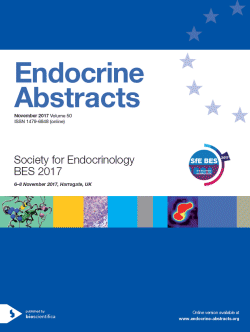Searchable abstracts of presentations at key conferences in endocrinology

Society for Endocrinology BES 2017
Harrogate,
UK
06 Nov 2017 - 08 Nov 2017

SfE BES 2017 will be on the 6-8 November 2016 in Harrogate, UK.
Symposia
When receptors go rogue
ea0050s2.1 | When receptors go rogue | SFEBES2017
Stress and direct targeting of mitochondrial gene expression by the glucocorticoid receptor in the brain
Glucocorticoids (GC) are involved recruiting the energetic response to stress and act principally via the glucocorticoid receptor (GR). The GR is classically understood to function as a nuclear transcription factor. However, the nuclear genome is not the only genome in eukaryotic cells. The mitochondria also contain a small circular chromosome the mitochondrial DNA (mtDNA) that encodes 13 proteins. It has been established that, in the brain and other systems, the...
ea0050s2.2 | When receptors go rogue | SFEBES2017
Dissecting thyroid hormone receptor action
Thyroid hormone (TH) and TH receptors (TRs) α and β are currently perceived as prototypical nuclear receptors, acting by binding to TH response elements (TREs) in regulatory regions of target genes. This nuclear signaling is long established as the canonical pathway for TH action. However, TRs can also act non-canonically, independent from DNA binding and outside the nucleus, by modulating second messenger signaling in vitro. Whether such non-canonical TR ac...
ea0050s2.3 | When receptors go rogue | SFEBES2017
Extra-nuclear estrogen receptors in breast cancer
Steroid receptors (SR) respond to binding of their ligands with rapid signal transduction resulting from engaging extra-nuclear receptors. This occurs in addition to the conventional aspects of steroids/nuclear SR that regulate gene transcription. In breast cancer, estrogen and progesterone receptors (ER, PR) are present at the plasma membrane in addition to the nucleus. Here the receptors activate many pathways as G-protein coupled receptors, resulting in epigenetic and genet...



